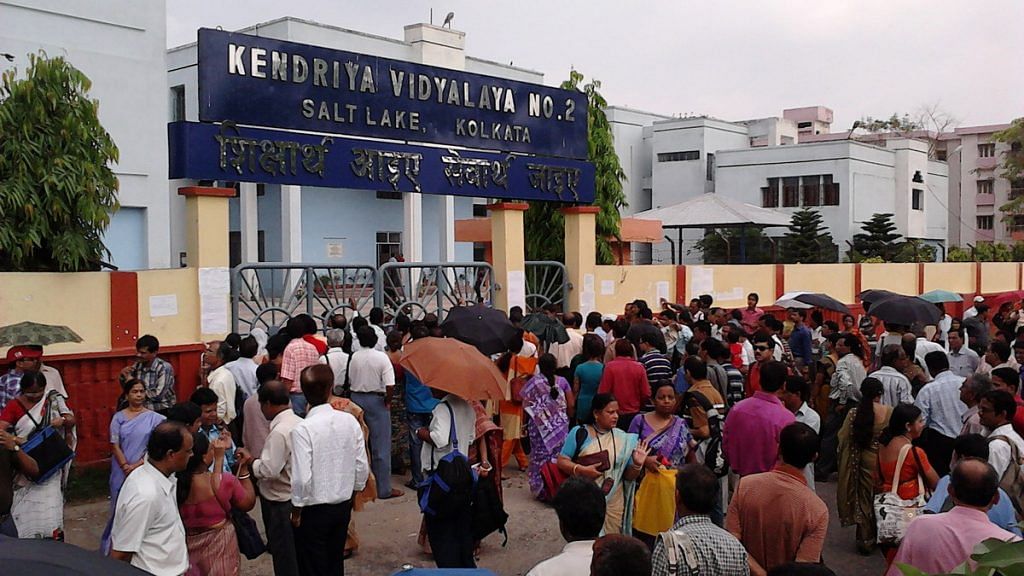New Delhi: Over the past seven years, the number of children of central government employees enrolling at the Kendriya Vidyalayas (KVs), for whom the schools were primarily set up, has seen a constant decline.
According to data shared by the Kendriya Vidyalaya Sangathan (KVS), the proportion of Kendriya Vidyalaya students who are children of central government employees has dropped to 47 per cent in 2017-18 from 60 per cent in 2011-12.
The KVS is an autonomous body under the Ministry of Human Resource Development (HRD) that manages and runs the 1,100 Kendriya Vidyalayas across the country.
Its data shows that of the 10,91,931 students across the KVs in 2011-12, 6,56,527 were children of central government employees. In 2017-18, of the 12,54,922 students across KVs, 5,92,436 belong to the category.
The data also shows that the enrolment of children from families, which are not in state or central government jobs, has seen a constant rise — from 25 per cent in 2011-12 to 36 per cent for 2017-18.
According to the KVS data, in 2011-12, 2,74,791 children were from the non-government category but this number increased by over 2 lakh students to reach 4,61,950 in 2017-18.
This despite the fact that when the KVs were set up across the country in the 1960s, their main purpose was to cater to children of central government employees who are on transferable and non-transferable jobs. The mandate was later expanded to include children of state government employees and then children from non-government families.
Also read: Larger Supreme Court bench to hear plea against Sanskrit shlokas, Hindi prayer at KVs
Why numbers are declining
Government officials familiar with the workings of the schools say that one of the reasons for the decline is that the KVs are opening up in areas where government employees don’t take their families along, such as in Jammu and Kashmir and in Naxal-affected districts.
“One of the reasons that admissions under category I, which is for central government employees’ children, is decreasing is because more and more KVs are opening up in areas where the staff don’t take their families — in remote parts of the country, in troubled areas and in Naxal areas,” said Uday Khaware, additional commissioner (academics), KVS.
“In all such places, the seats get taken up by children from either the normal category or whose parents work in the state government,” he added.
“We still give preference to children from the central government category but if they don’t apply, there is nothing that we can do. The normal category admissions are not increasing at the cost of government category,” Khaware said.
Another reason often cited by government officials is that after the Seventh Pay Commission, central government employees are now able to afford to send their children to private schools. The child study allowance per employee increased to Rs 2,250 per child a month in 2016 from Rs 1,500 per child per month.
“Most central government employees want to send their children to private schools because they can afford to do that and also because it’s a matter of prestige,” said an official who has worked with MoS HRD Upendra Kushwaha and who handles many KV admissions under MP quota.
“On the contrary, common people who cannot afford good private schools come to KVs because if given a choice between a state government school and a KV, they choose the latter.”
The Member of Parliament (MP) quota is another reason why more children from the non-government category get admission. Each MP is entitled to recommend 10 names each year for admission to KVs and, according to officials at KVS, they get almost 8,000 children a year under this quota.
Also read: Govt officials’ kids only in govt schools: Why proposed Karnataka scheme is unfeasible
Admission in KVs
There are five categories under which admission is granted for the 1,200 Kendriya Vidyalayas — children of transferable and non-transferable central government employees, including ex-servicemen; children of transferable and non-transferable employees of autonomous bodies/PSU of the central government; children of transferable and non-transferable state government employees; children of transferable and non- transferable employees of autonomous bodies/PSU of the state government and children of other category.
There is no entrance examination for the schools, which follow the CBSE syllabus, but children of government employees are given preference. Once granted admission, all students pay the same fee of Rs 1,100 a month.
The central government has been paying a lot of attention to KVs, touting them as its trademark schools for quality education. The budget for KVS has been increased by 37 per cent in the last four years — up to Rs 4,601 crore in the 2017-18 fiscal from Rs 2,827 crore in the 2013-14 financial year.
Just ahead of elections, the cabinet, chaired by Prime Minister Narendra Modi, approved the setting up of 50 new Kendriya Vidyalayas in the country. Of these, 29 will be set up in the civil sector and remaining under the defence sector.
